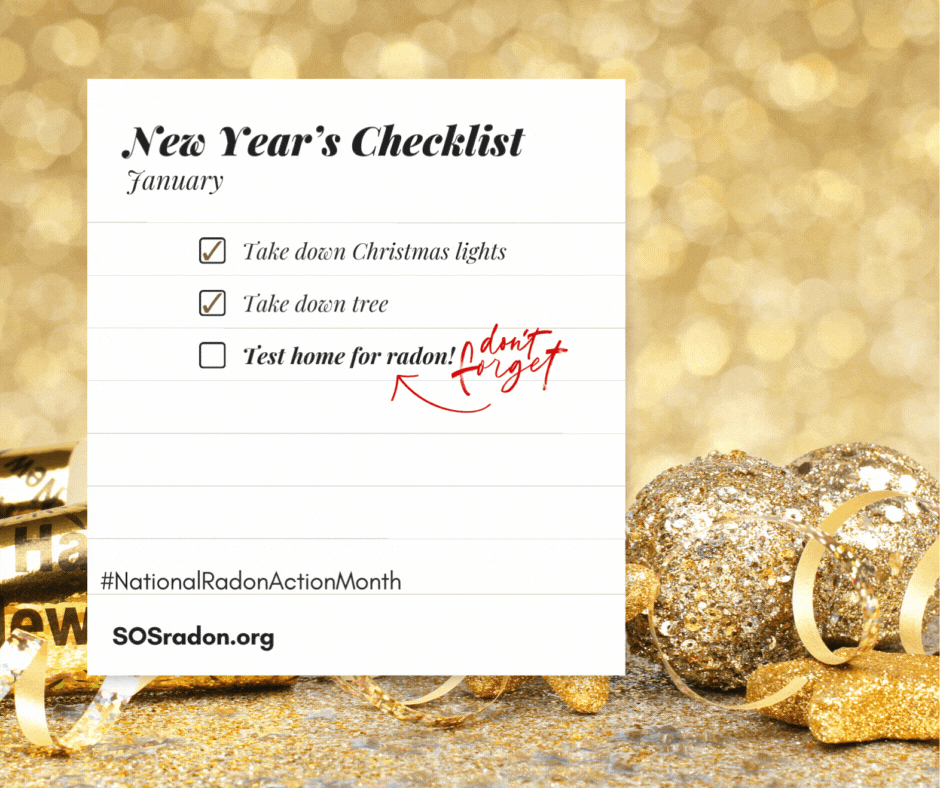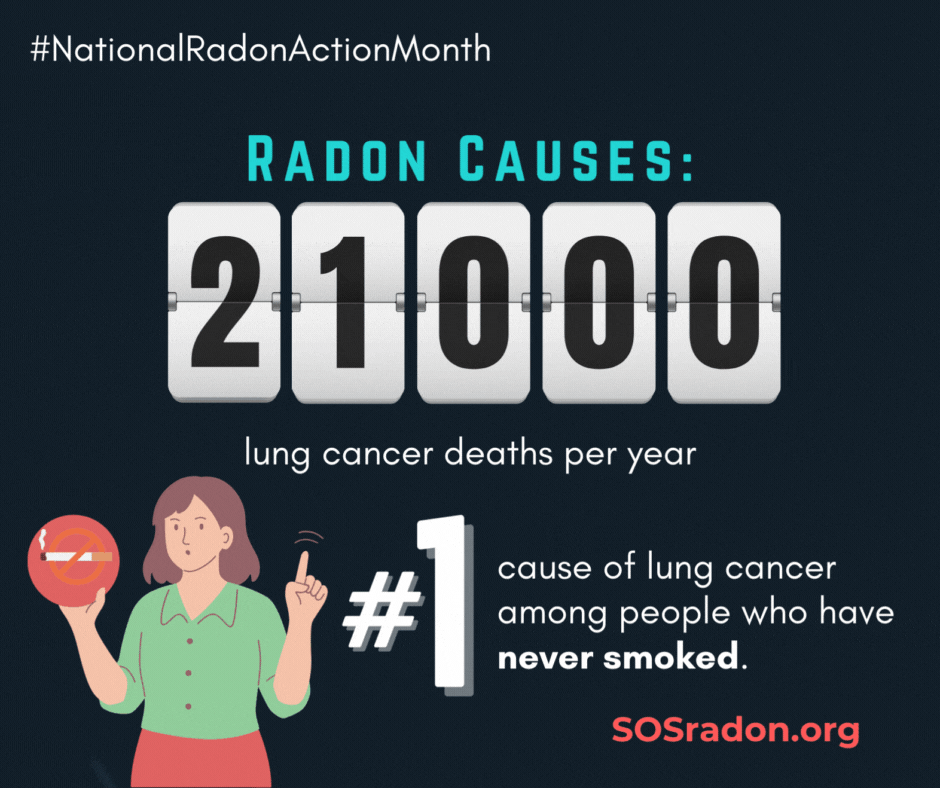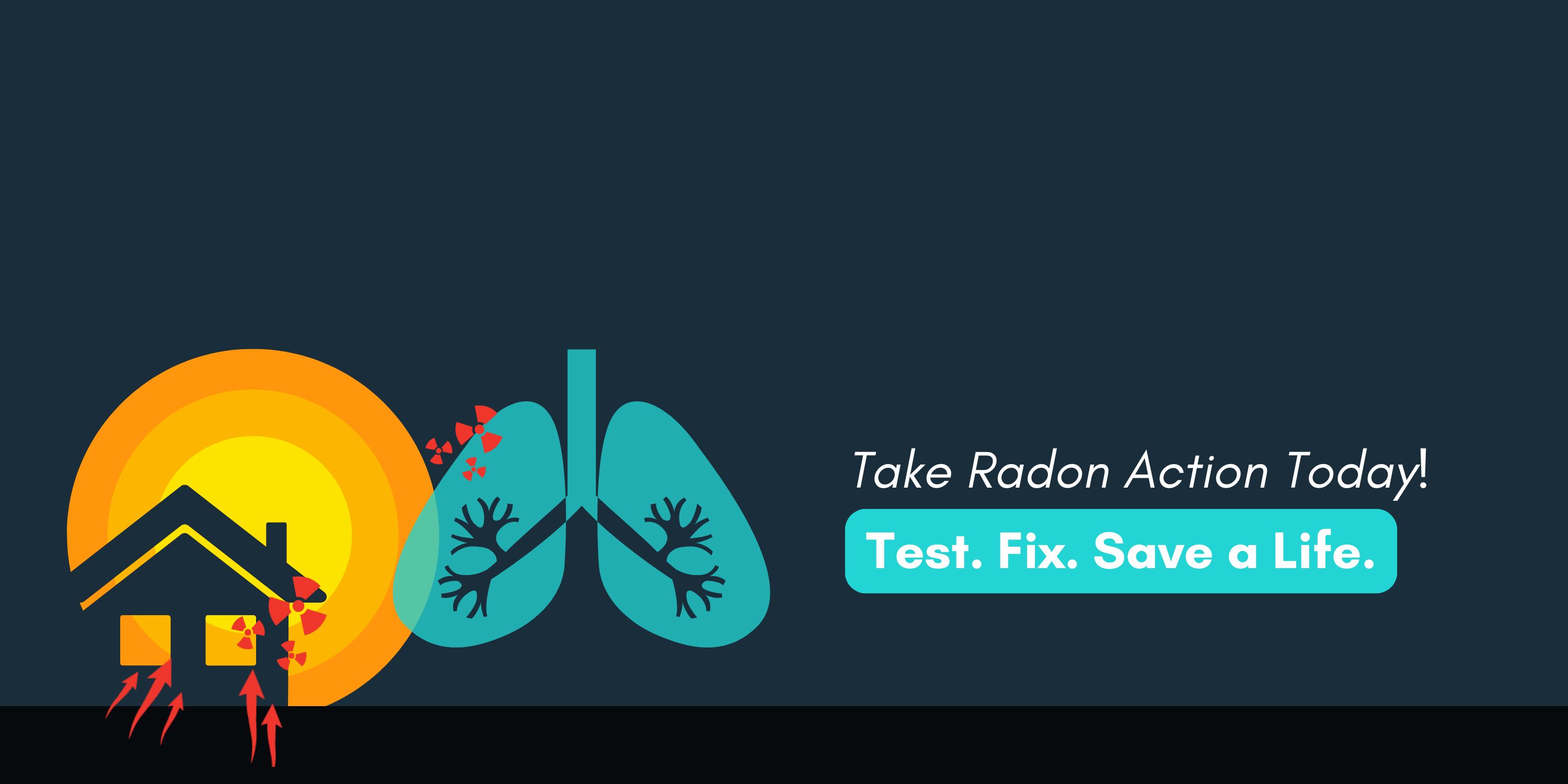National Radon Action Month
January is recognized as National Radon Action Month, dedicated to increasing public awareness about radon—a colorless, odorless radioactive gas that's the second leading cause of lung cancer in the U.S. This month encourages everyone to TAKE RADON ACTION by raising awareness and testing their homes for radon levels.
What can YOU do to take Radon Action?
- Raise awareness on social media. Our social media toolkit makes it easy to share pictures and messages.
- Use our posters and brochures to educate your community.
- Test your home! Testing is easy and kits can be purchased for around $20. Share your results with family and neighbors. Encourage them to test, too!
National Radon Action Month Social Media Toolkit
Browse our collection of customizable graphics designed to make sharing simple. We also encourage you to download our NEW "Protect Your Home From Radon Risks Video" for easy, engaging, and comprehensive radon content. This quick and informative resource demystifies what radon is, highlights the associated health risks, and provides simple ways to test for it in your own home. Available in English, Spanish and mobile-friendly formats!
Videos, Graphics and Messages
Click on a radon topic in the table below to view and download videos and graphics that are free for you to share! Then copy, paste and edit the suggested messages to accompany your image! For help sharing radon information on your website and social media, watch this instructional video.
Radon is a silent threat that can lurk in our homes, but knowledge is power! We encourage everyone to download and share the "Protect Your Home From Radon Risks" 1-minute video. This quick and informative resource demystifies what radon is, highlights the associated health risks, and provides simple ways to test for it in your own home. By sharing this video, you can help raise awareness and empower your friends and family to take action in safeguarding their health. Let's work together to protect our homes and loved ones from radon risks! Available in English, Spanish and mobile-friendly formats!
How to Download Images: Right-click on an image to save to your computer.
 WSU Environmental Finance Center
WSU Environmental Finance CenterMessage Idea:
When was the last time you tested your home for radon gas? It is recommended to test
every two to five years to ensure you and your loved ones are safe from elevated levels
of radon. Don’t put this off! Exposure to radon is the leading cause of lung cancer
in non-smokers. Test your living space today and address any high radon levels. Reducing
radon levels is possible with a professionally installed system and often costs less
than many other home repairs. Test. Fix. Save a life. #NationalRadonActionMonth
 CDC
CDCJanuary is #NationalRadonActionMonth! Test your home. Protect your health. Visit www.sosradon.org to learn more.
How to Download Images: Right-click on an image to save to your computer.
 CDC
CDCMessage Idea:
Radon is a gas you can’t see or smell, but it can cause severe health effects if high levels infiltrate your home. Test your home for radon today! Visit sosradon.org to learn more.
 CDC
CDCRadon is a radioactive gas that is produced through the natural radioactive decay of uranium found in rock, soil, and water. Low levels of uranium occur naturally throughout Earth's crust, and radon can be found in all 50 states. If you're looking for a meaningful New Year's Resolution, consider testing your home for radon. It's a great way to protect your family this year. January is #NationalRadonActionMonth, and you can learn more at sosradon.org.
 WSU Environmental Finance Center
WSU Environmental Finance CenterDid you know that radon is a natural gas that is colorless, odorless, and tasteless? Unless you test for it, there's no way to know how much is present in your home. You've taken down the lights and put away the decorations, but have you tested your home for radon? There's no better time than #NationalRadonActionMonth to do so! Learn more at sosradon.org.
How to Download Images: Right-click on an image to save to your computer.
 CDC
CDCRadon can enter your home through various entry points, including cracks, gaps, cavities, joints, sump pits, windows, and any openings it can find. It's essential to test your home for radon to ensure it is safe. Radon test kits are available at most hardware stores. To find a test kit, visit sosradon.org, and be sure to follow #NationalRadonActionMonth this January for more information.
 WSU Environmental Finance Center
WSU Environmental Finance CenterElevated radon levels can be present in any home, regardless of its age, size, construction, or location. Even if your home has a radon mitigation system in place, it’s important to test for radon every two years to ensure the system is functioning properly. This #NationalRadonActionMonth, learn how to protect your family from radon exposure by visiting sosradon.org. #NationalRadonActionMonth
 CDC: Image 1 of 2
CDC: Image 1 of 2A neighbor’s radon test does not determine if your home has radon. Radon levels can vary between homes, so it's crucial to test your own! Learn more at sosradon.org. #NationalRadonActionMonth
 CDC: Image 2 of 2
CDC: Image 2 of 2How to Download Images: Right-click on an image to save to your computer.
 CDC
CDCRadon is often referred to as "the silent killer" because it causes more than 21,000 deaths each year and is the leading cause of cancer among non-smokers. The good news is that lung cancer caused by radon is completely preventable. You can protect your home with a radon test and a radon mitigation system, both of which are surprisingly easy and more affordable than you might think! Learn how to safeguard your family at sosradon.org. #NationalRadonActionMonth
 CDC Image 1 of 2
CDC Image 1 of 2Radon is the leading cause of cancer in non-smokers. Don't take any chances; test your home as soon as possible and encourage a friend to do the same. Visit sosradon.org to learn more. #NationalRadonActionMonth
 CDC Image 2 of 2
CDC Image 2 of 2

Message Idea:
Avoiding smoking alone is not sufficient to prevent lung cancer. Each year, over 21,000
people in the U.S. die from lung cancer caused by radon exposure. Test your home today!
To learn more and find an affordable test kit, visit www.sosradon.org. #NationalRadonActionMonth
Message Idea:
Keep radon on your radar! Radon is the leading cause of lung cancer among non-smokers.
You can't see, smell, or taste radon, but it naturally occurs at high levels in 1
out of every 15 homes. Testing for radon is easy, affordable, and can save lives.
Visit sosradon.org to learn more. #NationalRadonActionMonth
How to Download Images: Right-click on an image to save to your computer.
 CDC
CDCIs this your first time testing for radon, or have you tested in the past 2-5 years? We recommend starting with a short-term test kit. Depending on the results, you may consider using a long-term test kit for a follow-up confirmation test. If you have any questions, please call the National Radon Hotline at (800) 767-7236. #NationalRadonActionMonth
 CDC
CDCMessage Idea:
Contact your state radon program (link below) for information on how to obtain a test
kit from a radon measurement professional. Some states also provide free or discounted
test kits to the public. The National Radon Program Services at Kansas State University
offers discounted test kits that can be purchased online at www.sosradon.org. Additionally, radon test kits are widely available at most hardware stores. #NationalRadonActionMonth
Missouri State Radon Program: https://health.mo.gov/living/environment/radon/index.php
Kansas State Radon Program: https://www.kansasradonprogram.org/
Iowa State Radon Program: https://hhs.iowa.gov/public-health/radiological-health/radon
Nebraska State Radon Program: https://dhhs.ne.gov/Pages/Radon-Test-Kits.aspx

January is #NationalRadonActionMonth. Have you tested your home for radon? If you haven't tested for radon in the last 2 to 5 years, it’s time to do so. Learn how at www.sosradon.org.
 CDC: Image 1 of 2
CDC: Image 1 of 2Did you test your home for radon this month or purchase a test kit? This is the first step to prevent your family from experiencing the serious health effects of breathing elevated radon levels. You can test for radon using DIY test kits, which are available at hardware stores or online for about $20. Will you take action on radon this month? Comment below and share this information with a family member or friend who might not be aware of the importance of testing for radon in their home! #NationalRadonActionMonth
 CDC Image 2 of 2
CDC Image 2 of 2Radon Brochures and Posters
 Utilize our posters and brochures to spread the word and educate your community, neighbors,
and friends. Available in English and Spanish and customized with data for Kansas, Iowa, Missouri,
and Nebraska. Click on the state below to download radon brochures and posters. (National
versions avaliable to download here.)
Utilize our posters and brochures to spread the word and educate your community, neighbors,
and friends. Available in English and Spanish and customized with data for Kansas, Iowa, Missouri,
and Nebraska. Click on the state below to download radon brochures and posters. (National
versions avaliable to download here.)
Contact: Leslie Kimble, Marketing Coordinator, leslie.kimble@wichita.edu
This project has been funded wholly or in part by the United States Environmental Protection Agency under assistance agreement (AI96701701) to Wichita State University Environmental Finance Center. The contents of this document do not necessarily reflect the views and policies of the Environmental Protection Agency, nor does the Environmental Protection Agency endorse trade names or recommend the use of commercial products mentioned in this document, as well as any images, video, text, or other content created by generative artificial intelligence tools, nor does any such content necessarily reflect the views and policies of the Environmental Protection Agency.


